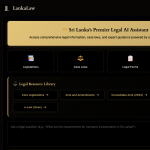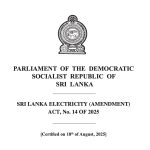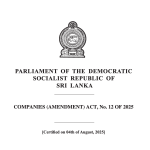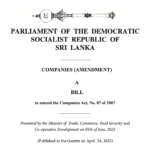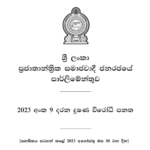Case Details
Suntel Limited v. Electroteks Network Services Private Limited and Dialog Broadband Network (Private) Limited. Case Number: SC/MISC/03/2019 Court: Supreme Court of the Democratic Socialist Republic of Sri Lanka. Judgment Date: 19 May 2023
Background of the Case
This case arises from a commercial dispute involving Suntel Limited, later amalgamated with Dialog Broadband Network (Private) Limited (the Plaintiff-Respondent), and Electroteks Network Services Private Limited (the Defendant-Petitioner). The matter initially began when Suntel Limited instituted an action in the Commercial High Court of the Western Province on 20 November 2001 to recover Rs. 68,765,407.91 in outstanding payments as of 3 October 2000.
Electroteks filed a counterclaim, asserting two primary claims:
- Rs. 41,040,185.12 as an overpayment.
- Rs. 4,180 million in damages comprising:
- Rs. 2,180 million for loss of profits over five years due to the wrongful disconnection of telephone services.
- Rs. 2,000 million for loss of goodwill.
While the trial was ongoing, Suntel Limited withdrew its case, resulting in the dismissal of its claims. However, Electroteks continued with its counterclaims, which led to a judgment in its favor by the Commercial High Court on 9 March 2012. Dialog Broadband Network (Private) Limited, having assumed the liabilities of Suntel, appealed to the Supreme Court, which reversed the Commercial High Court’s decision on 14 December 2018.
Dissatisfied with the Supreme Court’s ruling, Electroteks filed a petition seeking a review of the judgment, alleging bias and procedural irregularities.
Key Legal Issues
- Finality of Supreme Court Judgments:
- Article 127(1) of the Sri Lankan Constitution establishes the Supreme Court as the highest and final appellate court. Judgments rendered by the court are final and conclusive.
- Bias Allegations Against the Judges:
- The Defendant-Petitioner alleged bias on the grounds that the presiding judge’s son was professionally associated with a counsel representing the Plaintiff-Respondent in unrelated cases. However, there was no evidence that the judge’s son was involved in this particular case.
- Procedural Irregularities:
- The Defendant-Petitioner cited discrepancies, including two different judgment dates (12 December 2018 and 14 December 2018) and an assertion that only two days of argument (18 and 19 October 2016) were considered, despite ten days of proceedings.
- Use of Inherent Powers:
- The scope of inherent powers and whether they can be invoked to review final judgments were central to the court’s deliberation.
Court’s Analysis
- Finality of Judgments:
- The court reaffirmed that its judgments are final under Article 127(1). No statutory provision or inherent power allows the Supreme Court to review its own final appellate decisions except in narrowly defined circumstances.
- Bias Claims:
- The court noted that familial or professional relationships involving judges’ relatives do not automatically imply bias. The Defendant-Petitioner failed to provide direct evidence of partiality or conflict of interest in this case.
- Judgment Discrepancies:
- The court attributed the date discrepancies to a clerical error in the unsigned version published on the website. The official signed judgment held precedence.
- Procedural Objections:
- Although procedural correctness is critical, the Defendant-Petitioner did not demonstrate how specific submissions or arguments were improperly excluded.
- Inherent Powers:
- The court highlighted that inherent powers are limited to correcting accidental slips, clarifying ambiguous language, or addressing judgments made per incuriam. Allegations of judicial misconduct or bias do not fall within this purview.
Judgment
The Supreme Court dismissed the application, stating:
- Lack of Jurisdiction: The Constitution does not provide jurisdiction to review final judgments of the Supreme Court.
- Baseless Allegations: No substantial evidence supported the claims of bias or procedural misconduct.
- Inappropriate Invocation of Inherent Powers: Inherent powers cannot be used to create new jurisdiction or address grievances that do not involve clerical or manifest errors.
Legal Precedents Cited
The court referenced multiple cases to substantiate its position:
- Jeyaraj Fernandopulle v. Premachandra de Silva and Others (1996) 1 SLR 70:
- Established that the Supreme Court’s decisions are final and not subject to rehearing or review.
- Ganeshanatham v. Vivienne Goonewardena (1984) 1 SLR 321:
- Reinforced the principle of limited inherent powers for correcting demonstrable errors.
- Hettiarachchi v. Seneviratne (1994) 3 SLR 293:
- Clarified the restricted interpretation of per incuriam.
Conclusion and Implications
The dismissal of Electroteks’ petition reaffirms the principle of judicial finality in Sri Lanka’s legal system. It emphasizes the limited role of inherent powers in reviewing judgments and underscores the judiciary’s commitment to impartiality and procedural integrity. This case highlights the necessity for clear statutory guidance if broader review mechanisms are to be considered in future reforms.
Read Full Judgement


